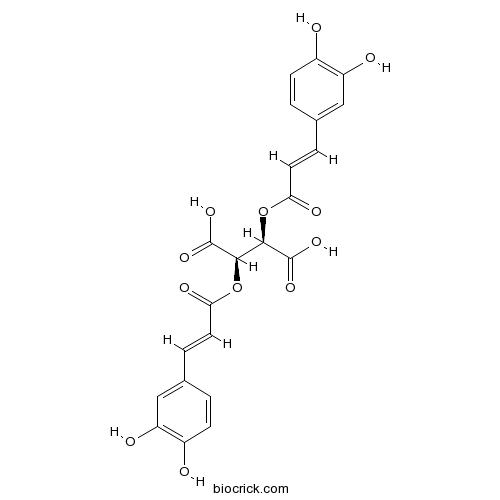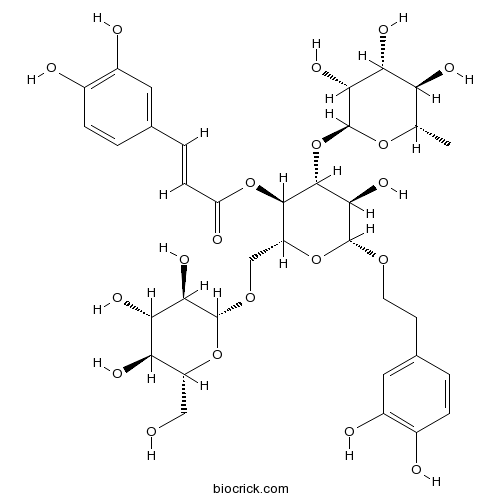Echinacea purpurea
Echinacea purpurea
1. The products in our compound library are selected from thousands of unique natural products; 2. It has the characteristics of diverse structure, diverse sources and wide coverage of activities; 3. Provide information on the activity of products from major journals, patents and research reports around the world, providing theoretical direction and research basis for further research and screening; 4. Free combination according to the type, source, target and disease of natural product; 5. The compound powder is placed in a covered tube and then discharged into a 10 x 10 cryostat; 6. Transport in ice pack or dry ice pack. Please store it at -20 °C as soon as possible after receiving the product, and use it as soon as possible after opening.
Natural products/compounds from Echinacea purpurea
- Cat.No. Product Name CAS Number COA
-
BCN9033
Cichoric acid6537-80-0
Instructions

-
BCN2096
Caftaric acid67879-58-7
Instructions

-
BCC8275
(1R)-(+)-Alpha-Pinene7785-70-8
Instructions

-
BCN4953
Echinacoside82854-37-3
Instructions

The effects of the dietary supplementation of Echinacea purpurea extract and/or vitamin C on the intestinal histomorphology, phagocytic activity, and gene expression of the Nile tilapia.[Pubmed: 30107260]
None
Cichoric Acid Prevents Free Fatty Acids Induced Lipid Metabolism Disorders via Regulating Bmal1 in HepG2 Cells.[Pubmed: 30036051]
Cichoric acid (CA), a polyphenol component from Echinacea purpurea, exhibits preventive effects on liver lipid metabolism disorders in obesity. This research aimed to determine the role of circadian rhythm signaling during the process of CA attenuated lipid accumulation in hepatocytes. In the current study, CA treatments improved cell morphology changes and hepatic lipid levels, which were triggered by free fatty acids (2:1, oleate: palmitate) in a dose dependent way. Besides, CA (200 μM) regulated the circadian rhythm expressions of clock genes and the relatively shallow daily oscillations. Moreover, silencing Bmal1 significantly blocked p-Akt/Akt pathway to 80.1% ± 1.5% and p-GSK3β/GSK3β pathway to 64.7% ± 2.8% (p < 0.05), and elevated the expressions of FAS and ACC to 122.4% ± 5.6% and 114.9% ± 1.7% in protein levels (p < 0.05), 166.5% ± 18.5% and 131.4% ± 5.5% in mRNA levels additionally (p < 0.05). Therefore, our results demonstrated that CA has a Bmal1 resistance to lipid accumulation by enhancing the Akt/GSK3β signaling pathways and modulating the downstream expressions related to lipid metabolism, which indicated that CA might be served as a natural and promising non-alcoholic fatty liver diseases (NAFLD) modulator.
Antagonism and antibiotic resistance drive a species-specific plant microbiota differentiation in Echinacea spp.[Pubmed: 29912319]
A key factor in the study of plant-microbes interactions is the composition of plant microbiota, but little is known about the factors determining its functional and taxonomic organization. Here we investigated the possible forces driving the assemblage of bacterial endophytic and rhizospheric communities, isolated from two congeneric medicinal plants, Echinacea purpurea (L.) Moench and Echinacea angustifolia (DC) Heller, grown in the same soil, by analysing bacterial strains (isolated from three different compartments, i.e. rhizospheric soil, roots and stem/leaves) for phenotypic features such as antibiotic resistance, extracellular enzymatic activity, siderophore and indole 3-acetic acid production, as well as cross-antagonistic activities. Data obtained highlighted that bacteria from different plant compartments were characterized by specific antibiotic resistance phenotypes and antibiotic production, suggesting that the bacterial communities themselves could be responsible for structuring their own communities by the production of antimicrobial molecules selecting bacterial-adaptive phenotypes for plant tissue colonization.


